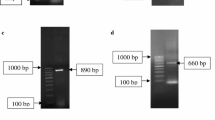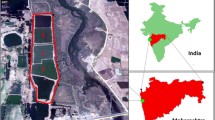Abstract
In this work, herbivorous fish Mugil cephalus has been cultured to secrete protein rich green slime, which helps nitrifying and oxygen tolerant denitrifying bacteria to grow and colonize. Four strains representing Alcaligenaceae family have been isolated from greenwater system and characterized using biochemical test, fatty acid methyl ester (GC-FAME) analysis, 16S rRNA and functional gene approaches. They were tested for an ability to nitrify ammonia and nitrite aerobically. Two strains showed notable nitrification activity, when grown in a mineral salts medium containing ammonium sulfate and potassium nitrite. Functional gene analysis confirmed the presence of nitrous oxide reductase (nosZ) gene showing that they have an oxygen-tolerant denitrification system. It has been proposed that Alcaligenes faecalis strains heterotrophically nitrify ammonia into nitrite via formation of hydroxyl amine, which is oxidized to nitrous oxide using oxygen or nitrite as electron acceptor. These results provide a possible advantage of having nitrification and denitrification capabilities in the same organism, which plays an important role in biological wastewater system.







Similar content being viewed by others
References
Walsh, P. J., & Wright, P. A. (1995). Nitrogen Metabolism and Excretion (p. 352). Florida, USA: CRC Press.
Focht, D. D., & Verstraete, W. (1977). Biochemical ecology of nitrification and denitrification. Advances in Microbial Ecology, 1, 135–214.
Winogradsky, S. (1890). Recherches sur les organismes de la nitrification. Annales de l'Institut Pasteur. Microbiology, 4, 213–231.
Daum, H., Zimmer, W., Papen, H., Kloos, K., Nawrath, K., & Bothe, H. (1998). Physiological and molecular biological characterization of ammonia oxidation of the heterotrophic nitrifier Pseudomonas putida. Current Microbiology, 37, 281–288.
Papen, H., Von-Berg, R., Hinkel, I., Thoene, B., & Rennenberg, H. (1989). Heterotrophic nitrification by Alcaligenes faecalis: NO2, NO3, N2O, and NO. Production in exponentially growing cultures. Applied and Environmental Microbiology, 55(8), 2068–2072.
Witzel, K. P., & Overbeck, H. J. (1979). Heterotrophic nitrification by Arthrobacter sp. (strain 9006) as influenced by different cultural conditions, growth state and acetate metabolism. Archives of Microbiology, 122, 137–143.
Robertson, L. A., & Kuenen, J. G. (1988). Heterotrophic nitrification in Thiosphaera pantotropha: oxygen uptake and enzyme studies. Journal of General Microbiology, 134, 857–863.
VanNiel, E. W., Braker, K. J., Robertson, L. A., & Kuenen, J. G. (1992). Heterotrophic nitrification and aerobic denitrification in Alacaligenes faecalis strain TUD. Antonie Van Leeuwenhoek, 62, 231–237.
Su, J. J., Yeh, K. S., & Tseng, P. W. (2006). A strain of Pseudomonas sp. Isolated from Piggery wastewater treatment systems with heterotrophic nitrification capability in Taiwan. Current Microbiology, 53, 77–81.
Castigenettii, D., & Hollocher, T. C. (1984). Heterotrophic nitrification among denitrifiers. Applied and Environmental Microbiology, 47, 4620–4623.
Robertson, L. A., Cornelisse, R., De Vos, P., Hadioetomo, R., & Kuenen, J. G. (1989). Aerobic denitrification in various heterotrophic nitrifiers. Antonie Van Leeuwenhoek, 56(4), 289–299.
Emery, T. (1974). Biosynthesis and mechanism of action of hydroxamate-type siderochromes. In J. B. Neilands (Ed.), Microbial metabolism, a comprehensive treatise (pp. 107–123). New York: Academic Press, Inc.
Baliao, D. D., De Los Santo, M. A., & Franco, N. M. (1999). Milkfish pond culture. Aquaculture Extension manual no. 25. Ilo-ilo: SEAFDEC.
Baliao, D. D. (2000). Environment-friendly schemes in intensive shrimp farming. State of the art Series. Ilo-ilo: SEAFDEC.
Strickland, J. D., & Parsons, T. R. (1972). A manual of seawater analysis. Canada Fisheries Research Board Bulletin, 167, 310.
APHA, AWWA, WEF. (1989). Standard methods for the examination of water and wastewater (17th ed.). Washington, DC, USA: American Public Health Association.
Sasser, M. (1990). Technical note 101: Bacterial identification by gas chromatographic analysis of fatty acids methyl esters (GC-FAME). North Newark, Del: MIDI, Inc.
Krishnani, K. K. (2010). Detection and diversity of nitrifying and denitrifying bacteria in coastal aquaculture. Aquaculture, 302, 57–70.
Thompson, J. D., Higgins, D. G., & Gibson, T. J. (1994). CLUSTAL W: improving the sensitivity of progressive multiple sequence alignment through sequence weighting, position specific gap penalties and weight matrix choice. Nucleic Acids Research, 22(22), 4673–4680.
Tamura, K., Dudley, J., Nei, M., & Kumar, S. (2007). MEGA4: molecular evolutionary genetics analysis (MEGA) software version 4.0. Molecular Biology and Evolution, 24, 1596–1599.
Daniels, L., Hanson, R. S., & Phillips, J. A. (1994). Chemical analysis. In: Gerhardt P, Murray RGE, Wood WA, Krieg NR(eds). Methods for general and molecular bacteriology. Washington DC: American Society for Microbiology, pp. 357–539, 541–2.
Coenye, T., Vancanneyt, M., Cnockaert, M. C., Falsen, E., Swings, J., & Vandamme, P. (2003). Kerstersia gyiorum gen. nov., sp. nov., a novel Alcaligenes faecalis-like organism isolated from human clinical samples, and reclassification of Alcaligenes denitrificans Ruger and Tan 1983 as Achromobacter denitrificans comb. Nov. International Journal of Systematic and Evolutionary Microbiology, 53, 1825–1831.
Rehfuss, M., & Urban, J. (2005). Alcaligenes faecalis subsp. phenolicus subsp. nov. a phenol-degrading, denitrifying bacterium isolated from a graywater bioprocessor. Systematic and Applied Microbiology, 28(5), 421–429.
Kersters, K., & De Ley, J. (1984). Genus Alcaligenes Castellani and Chalmers (1919). In N. R. Krieg & J. G. Holt (Eds.), Bergeys manual of systematic bacteriology (Vol. 1, pp. 361–373). Baltimore: Williams and Wilkins.
Nishio, T., Yoshikura, T., Chiba, K., & Inouye, Z. (1994). Effects of organic acids on heterotrophic nitrification by Alcaligenes faecalis OKK17. Bioscience, Biotechnology, and Biochemistry, 58(9), 1574–1578.
Rotthauwe, J. H., Boer, W., & Liesack, W. (1997). The ammonia monooxygenase structural gene amoA as a functional marker, molecular ¢ne scale analysis of natural ammonia oxidizing populations. Applied and Environmental Microbiology, 63, 4704–4712.
Holmes, A. J., Costello, A., Lidstrom, M. E., & Murrell, J. C. (1995). Evidence that particulate methane monooxynase and ammonia monooxynase may be evolutionary related. FEMS Microbiology Letters, 132, 203–208.
Krishnani, K. K., & Kathiravan, V. (2010). A quantitative method for detecting ammonia-oxidizing bacteria in coastal aquaculture systems. Aquaculture Research, 41, 1648–1657.
Ono, Y., Makino, N., Hoshino, Y., Shoji, K., & Yamanaka, T. (1996). An iron dioxygenase from Alcaligenes faecalis catalyzing the oxidation of pyruvic oxime to nitrite. FEMS Microbiology Letters, 139(2–3), 103–108.
Castignetti, D., & Gunner, H. B. (1981). Nitrite and nitrate synthesis from pyruvic oxime by an Alcaligenes sp. Current Microbiology, 5, 379–384.
Taylor, S. M., He, Y., Zhao, B., & Huang, J. (2009). Heterotrophic ammonium removal characteristics of an aerobic heterotrophic nitrifying-denitrifying bacterium, Providencia rettgeri YL. Journal of Environmental Sciences, 21(10), 1336–1341.
Wehrfritz, J. M., Reilly, A., Spiro, S., & Richardson, D. J. (1993). Purification of hydroxylamine oxidase from Thiosphaera pantotropha. Identification of electron acceptors that couple heterotrophic nitrification to aerobic denitrification. FEBS Letters, 335(2), 246–250.
Wehrfritz, J., Carter, J. P., Spiro, S., & Richardson, D. J. (1996). Hydroxylamine oxidation in heterotrophic nitrate-reducing soil bacteria and purification of a hydroxylamine-cytochrome c oxidoreductase from a Pseudomonas species. Archives of Microbiology, 166(6), 421–424.
Wunderlin, P., Mohn, J., & Joss, A. (2012). Mechanisms of N2O production in biological wastewater treatment under nitrifying and denitrifying conditions. Water Research, 46(4), 1027–1037.
Kampschreur, M. J., van der Star, W. R., Wielders, H. A., Mulder, J. W., Jetten, M. S., & van Loosdrecht, M. C. (2008). Dynamics of nitric oxide and nitrous oxide emission during full-scale reject water treatment. Water Research, 42(3), 812–826.
Campos, J. L., Arrojo, B., Vazquez-Padín, J. R., Mosquera-Corral, A., & Mendez, R. (2009). N(2)O production by nitrifying biomass under anoxic and aerobic conditions. Applied Biochemistry and Biotechnology, 152(2), 189–198.
Xie, W. M., Ni, B. J., Li, W. W., Sheng, G. P., Yu, H. Q., & Song, J. (2012). Formation and quantification of soluble microbial products and N2O production by ammonia-oxidizing bacteria (AOB)-enriched activated sludge. Chemical Engineering Science, 71, 67–74.
Gupta, A. B. (1997). Thiosphaera pantotropha: A sulphur bacterium capable of simultaneous heterotrophic nitrification and aerobic denitrification. Enzyme and Microbial Technology, 21, 589–595.
Robertson, L. A., Van Niel, E. W. J., Torremans, R. A. M., & Kuenen, J. G. (1988). Simultaneous nitrification and denitrification in aerobic chemostat cultures of Thiosphaera pantotropha. Applied and Environmental Microbiology, 54, 2812–2818.
Chen, Z., Liu, J., Wu, M., Xie, X., Wu, J., & Wei, W. (2011). Differentiated response of denitrifying communities to fertilization regime in paddy soil. Microbial Ecology, 63, 446–459.
Su, J. J., Liu, B. Y., & Liu, C. Y. (2001). Comparison of aerobic denitrification under high oxygen atmosphere by Thiosphaera pantotropha ATCC 35512 and Pseudomonas stutzeri SU2 newly isolated from the activated sludge of a piggery wastewater treatment system. Journal of Applied Microbiology, 90, 457–462.
Kim, M., Jeong, S., Yoon, S. J., Cho, S. J., Kim, Y. H., Kim, M. J., et al. (2008). Aerobic denitrification of Pseudomonas putida AD-21 at different C/N ratios. Journal of Bioscience and Bioengineering, 106, 498–502.
Zhao, B., He, Y. L., Hughes, J., & Zhang, X. F. (2010). Heterotrophic nitrogen removal by a newly isolated Acinetobacter calcoaceticus HNR. Bioresource Technology, 101, 5194–5200.
Ju, D. H., Choi, M. K., Ahn, J. H., Kim, M. H., Cho, J. C., Kim, T., et al. (2007). Molecular and ecological analyses of microbial community structures in biofilms of a full-scale Aerated Up-Flow Biobead process. Journal of Microbiology and Biotechnology, 17(2), 253–261.
Castignetti, D., & Hollocher, T. C. (1982). Nitrogen redox metabolism of a heterotrophic nitrifying-denitrifying Alcaligenes sp. from soil. Applied and Environmental Microbiology, 44, 923–928.
Baker, G. C., Smith, J. J., & Cowan, D. A. (2003). Reviews and reanalysis of domain-specific 16S primers. Journal of Microbiological Methods, 55, 541–555.
Hirayama, H., Takai, K., Inagaki, F., Yamato, Y., Suzuki, M., Nealson, K. H., et al. (2005). Bacterial community shift along a subsurface geothermal water stream in a Japanese gold mine. Extremophiles, 9, 169–184.
Flanagan, D. A., Gregory, L. G., Carter, J. P., Karakas-Sen, A., Richardson, D. J., & Spiro, S. (1999). Detection of genes for periplasmic nitrate reductase in nitrate respiring bacteria and in community DNA. FEMS Microbiology Letters, 177, 263–270.
Philippot, L., Piutti, S., Martin-Laurent, F., Hallet, S., & Germon, J. C. (2002). Molecular analysis of the nitrate-reducing community from unplanted and maize-planted soils. Applied and Environmental Microbiology, 68, 6121–6128.
Braker, G., Fesefeldt, A., & Witzel, K. P. (1998). Development of PCR primer systems for amplification of nitrite reductase genes (nirK and nirS) to detect denitrifying bacteria in environmental samples. Applied and Environmental Microbiology, 64, 3769–3775.
Braker, G., & Tiedje, J. M. (2003). Nitric oxide reductase (norB) genes from pure cultures and environmental samples. Applied and Environmental Microbiology, 69, 3476–3483.
Kloos, K., Mergel, A., Rosch, C., & Bothe, H. (2001). Denitrification within the genus Azospirillum and other associative bacteria. Australian Journal of Plant Physiology, 28, 991–998.
Scala, D. J., & Kerkhof, L. J. (1998). Nitrous oxide reductase (nosZ) gene-specific PCR primers for detection of denitrifiers and three nosZ genes from marine sediments. FEMS Microbiology Letters, 162, 61–68.
Acknowledgments
The authors are grateful to Dr. A.G. Ponniah, Director, Central Institute of Brackishwater Aquaculture, Chennai for providing facilities to carry out this work. Financial assistance from Department of Biotechnology, Ministry of Science and Technology, Govt. of India is gratefully acknowledged.
Author information
Authors and Affiliations
Corresponding author
Rights and permissions
About this article
Cite this article
Velusamy, K., Krishnani, K.K. Heterotrophic Nitrifying and Oxygen Tolerant Denitrifying Bacteria from Greenwater System of Coastal Aquaculture. Appl Biochem Biotechnol 169, 1978–1992 (2013). https://doi.org/10.1007/s12010-013-0109-2
Received:
Accepted:
Published:
Issue Date:
DOI: https://doi.org/10.1007/s12010-013-0109-2




